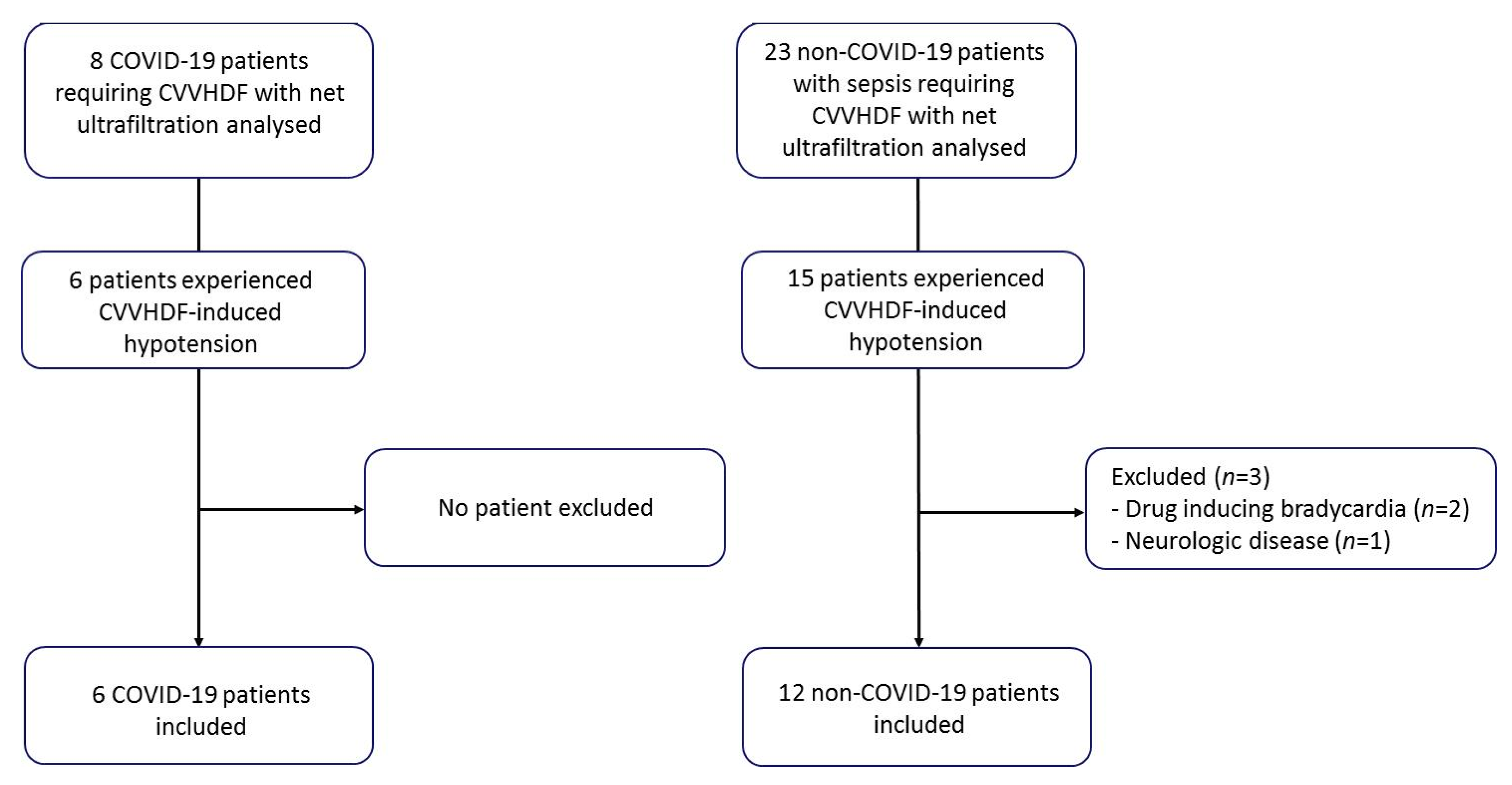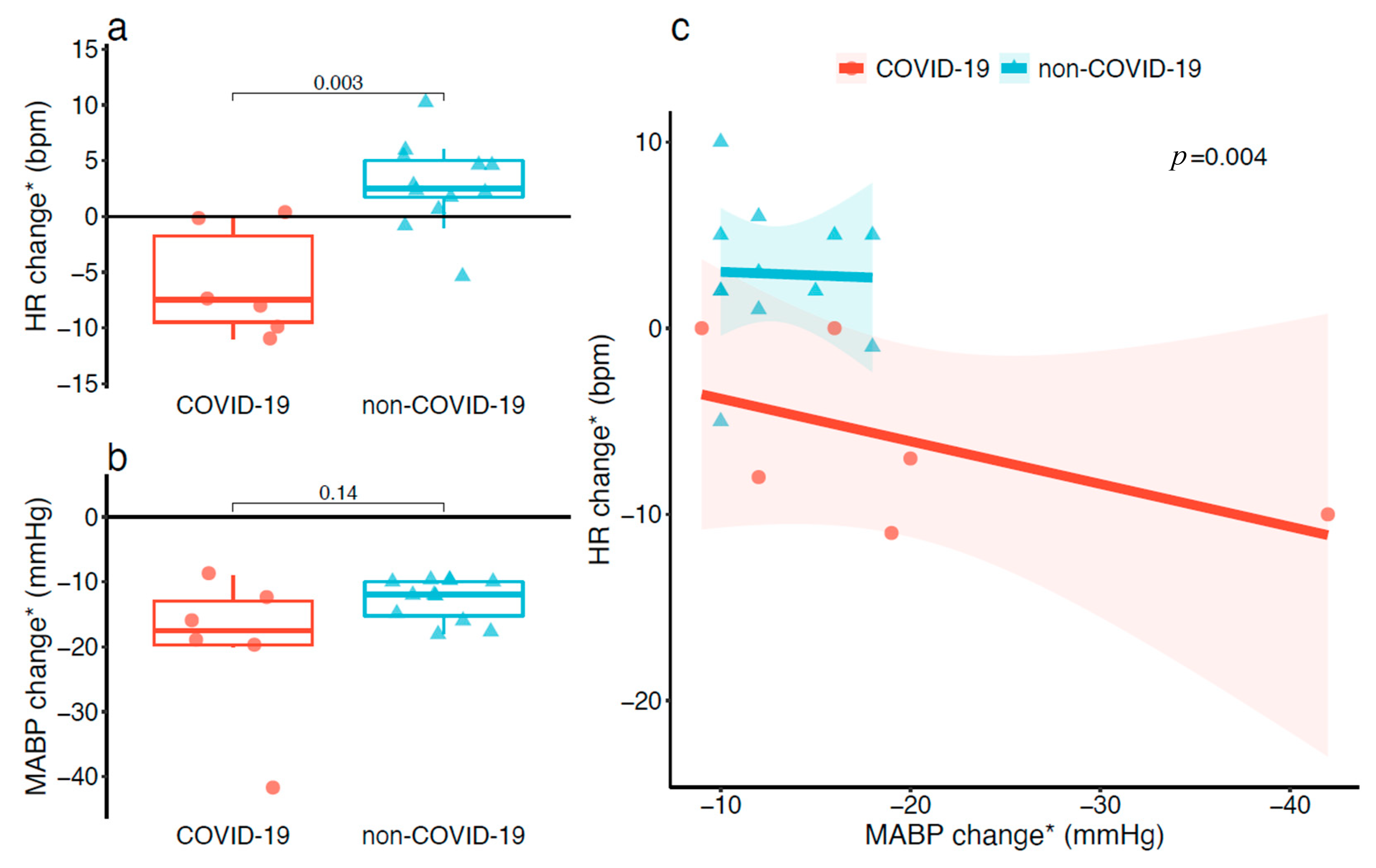Inappropriate Heart Rate Response to Hypotension in Critically Ill COVID-19-Associated Acute Kidney Injury
Abstract
1. Introduction
2. Materials and Methods
3. Results
4. Discussion
5. Conclusions
Supplementary Materials
Author Contributions
Funding
Institutional Review Board Statement
Informed Consent Statement
Data Availability Statement
Acknowledgments
Conflicts of Interest
References
- Vaduganathan, M.; Vardeny, O.; Michel, T.; McMurray, J.J.V.; Pfeffer, M.A.; Solomon, S.D. Renin-Angiotensin-Aldosterone System Inhibitors in Patients with Covid-19. N. Engl. J. Med. 2020, 382, 1653–1659. [Google Scholar] [CrossRef] [PubMed]
- Xia, H.; Lazartigues, E. Angiotensin-Converting Enzyme 2: Central Regulator for Cardiovascular Function. Curr. Hypertens. Rep. 2010, 12, 170–175. [Google Scholar] [CrossRef] [PubMed]
- Ghosn, M.; Attallah, N.; Badr, M.; Abdallah, K.; De Oliveira, B.; Nadeem, A.; Varghese, Y.; Munde, D.; Salam, S.; Abduljawad, B.; et al. Severe Acute Kidney Injury in Critically Ill Patients with COVID-19 Admitted to ICU: Incidence, Risk Factors, and Out-comes. J. Clin. Med. 2021, 10, 1217. [Google Scholar] [CrossRef]
- Armaly, Z.; Kinaneh, S.; Skorecki, K. Renal Manifestations of Covid-19: Physiology and Pathophysiology. J. Clin. Med. 2021, 10, 1216. [Google Scholar] [CrossRef]
- Assimon, M.M.; Flythe, J.E. Definitions of Intradialytic Hypotension. Semin. Dial. 2017, 30, 464–472. [Google Scholar] [CrossRef] [PubMed]
- Douvris, A.; Zeid, K.; Hiremath, S.; Bagshaw, S.M.; Wald, R.; Beaubien-Souligny, W.; Kong, J.; Ronco, C.; Clark, E.G. Mechanisms for Hemodynamic Instability Related to Renal Replacement Therapy: A Narrative Review. Intensive Care Med. 2019, 45, 1333–1346. [Google Scholar] [CrossRef] [PubMed]
- COVID-ICU Group on behalf of the REVA Network and the COVID-ICU Investigators. Clinical Characteristics and Day-90 Outcomes of 4244 Critically Ill Adults with COVID-19: A Prospective Cohort Study. Intensive Care Med. 2020, 47, 60–73. [Google Scholar] [CrossRef]
- Amaratunga, E.A.; Corwin, D.S.; Moran, L.; Snyder, R. Bradycardia in Patients With COVID-19: A Calm Before the Storm? Cureus 2020, 12, e8599. [Google Scholar] [CrossRef] [PubMed]
- Carod-Artal, F.J. Infectious Diseases Causing Autonomic Dysfunction. Clin. Auton. Res. 2018, 28, 67–81. [Google Scholar] [CrossRef] [PubMed]
- Schmidt, H.; Müller-Werdan, U.; Hoffmann, T.; Francis, D.P.; Piepoli, M.F.; Rauchhaus, M.; Prondzinsky, R.; Loppnow, H.; Buerke, M.; Hoyer, D.; et al. Autonomic Dysfunction Predicts Mortality in Patients with Multiple Organ Dysfunction Syndrome of Different Age Groups. Crit. Care Med. 2005, 33, 1994–2002. [Google Scholar] [CrossRef] [PubMed]
- Doobay, M.F.; Talman, L.S.; Obr, T.D.; Tian, X.; Davisson, R.L.; Lazartigues, E. Differential Expression of Neuronal ACE2 in Transgenic Mice with Overexpression of the Brain Renin-Angiotensin System. Am. J. Physiol. Regul. Integr. Comp. Physiol. 2007, 292, R373–R381. [Google Scholar] [CrossRef] [PubMed]
- Diz, D.I.; Garcia-Espinosa, M.A.; Gegick, S.; Tommasi, E.N.; Ferrario, C.M.; Ann Tallant, E.; Chappell, M.C.; Gallagher, P.E. Injections of Angiotensin-Converting Enzyme 2 Inhibitor MLN4760 into Nucleus Tractus Solitarii Reduce Baroreceptor Reflex Sensitivity for Heart Rate Control in Rats. Exp. Physiol. 2008, 93, 694–700. [Google Scholar] [CrossRef] [PubMed]
- Xia, H.; Suda, S.; Bindom, S.; Feng, Y.; Gurley, S.B.; Seth, D.; Navar, L.G.; Lazartigues, E. ACE2-Mediated Reduction of Oxidative Stress in the Central Nervous System Is Associated with Improvement of Autonomic Function. PLoS ONE 2011, 6, e22682. [Google Scholar] [CrossRef] [PubMed]
- Levitan, D.; Massry, S.G.; Romoff, M.S.; Campese, V.M. Autonomic Nervous System Dysfunction in Patients with Acute Renal Failure. Am. J. Nephrol. 1982, 2, 213–220. [Google Scholar] [CrossRef] [PubMed]


| Variables | All Patients (n = 18) | COVID-19 Patients (n = 6) | Non-COVID-19 Patients (n = 12) | p-Value |
|---|---|---|---|---|
| Baseline clinical characteristics | ||||
| Gender (male) | 12 (66.7) | 5 (83.3) | 7 (58.3) | 0.60 |
| Age, years | 63 (53–69) | 58 (53–64) | 67.0 (51–71) | 0.30 |
| Arterial hypertension | 12 (66.7) | 5 (83.3) | 7 (58.3) | 0.60 |
| Diabetes mellitus | 7 (38.9) | 3 (50.0) | 4 (33.3) | 0.63 |
| Congestive heart failure | 1 (5.6) | 0 | 1 (8.3) | 0.47 |
| Chronic dialysis | 3 (16.7) | 2 (33.3) | 1 (8.3) | 0.24 |
| Clinical and laboratory findings * | ||||
| Core temperature, °C † | 37.7 (36.3–37.0) | 36.7 (36.4–36.9) | 36.8 (36.3–37.1) | 0.96 |
| Richmond Agitation Sedation Scale | −5.0 (−5.0–−0.8) | −5.0 (−5.0–0.0) | −4.5 (−5.0–−1.5) | 0.88 |
| Natremia, mmol/L | 141 (138–142) | 139 (138–140) | 141 (140–142) | 0.24 |
| Kaliemia, mmol/L | 4.0 (3.8–4.2) | 3.8 (3.7–4.0) | 4.1 (3.9–4.2) | 0.16 |
| Calcemia, mmol/L | 2.46 (2.37–2.61) | 2.51 (2.43–2.70) | 2.43 (2.36–2.59) | 0.48 |
| Magnesemia, mmol/L | 1.00 (0.91–1.06) | 0.98 (0.91–1.01) | 1.01 (0.93–1.08) | 0.51 |
| Phosphatemia, mmol/L | 1.43 (1.32–1.60) | 1.46 (1.31–1.68) | 1.43 (1.37–1.54) | 0.85 |
| Management † | ||||
| Invasive mechanical ventilation | 18 (100) | 6 (100) | 12 (100) | >0.99 |
| Volume-controlled ventilation | 12 (67) | 4 (67) | 8 (67) | >0.99 |
| Pressure support ventilation | 6 (33) | 2 (33) | 4 (33) | >0.99 |
| PEEP, cmH20 | 6.0 (6.0–8.5) | 10.0 (8.0–10.5) | 6.0 (5.3–6.0) | 0.002 |
| PaO2/FiO2 | 157 (122–225) | 140 (112–128) | 182 (128–239) | 0.42 |
| Tidal volume, mL/kg PBW ‡ | 6.3 (5.8–6.8) | 6.4 (5.8–7.0) | 6.1 (5.9–6.5) | 0.88 |
| Catecholamine | ||||
| Norepinephrine | 9 (50.0) | 3 (50.0) | 6 (50.0) | >0.99 |
| Norepinephrine dose, µg/kg/min | 0.12 (0.10–0.20) | 0.12 (0.11–0.13) | 0.16 (0.11–0.31) | 0.71 |
| Epinephrine | 1 (5.6) | 0 | 1 (8.3) | >0.99 |
| Epinephrine dose, µg/kg/min | 0.2 | 0 | 0.2 | >0.99 |
| CVVHDF parameters | ||||
| Ultrafiltration rate, mL/h | 100 (100–172) | 100 (100–137) | 125 (50–250) | 0.92 |
| Blood flow rate, mL/min | 150 (150–150) | 150 (150–153) | 150 (150–150) | 0.91 |
| Dialysate flow rate, mL/h | 3000 (2700–3150) | 3000 (3000–3200) | 3000 (2875–3050) | 0.39 |
| Sedative drugs | ||||
| Propofol | 17 (94.4) | 6 (100) | 11 (91.7) | 0.92 |
| Propofol dose, mg/h | 200 (150–200) | 200 (200–200) | 160 (75–200) | 0.02 |
| Sufentanil | 18 (100) | 6 (100) | 12 (100) | >0.99 |
| Sufentanil dose, µg/h | 20 (10.0–20) | 20 (20–27) | 20 (10–20) | 0.18 |
| Midazolam | 6 (33.3) | 4 (66.7) | 2 (16.7) | 0.11 |
| Midazolam dose, mg/h | 0.0 (0.0–2.8) | 4 (0.8–5.0) | 0 (0–0) | 0.02 |
| Ketamine | 1 (5.6) | 0 (0.0) | 1 (8.3) | >0.99 |
| Ketamine dose, mg/h | 0 (0–0) | 0 (0–0) | 0 (0–0) | 0.48 |
| Neuromuscular-blocking agents | 9 (50.0) | 5 (83.3) | 4 (33.3) | 0.13 |
| Hemodynamic parameters | ||||
| Before CVVHDF-induced hypotension † | ||||
| Heart rate, bpm | 108 (84–120) | 114 (85–119) | 100 (89–120) | 0.89 |
| MABP, mmHg | 74 (70–75) | 78 (73–79) | 72 (67–74) | 0.08 |
| SABP, mmHg | 118 (105–127 | 122 (117–128) | 117 (105–124) | 0.40 |
| DABP, mmHg | 54 (51–57) | 57 (53–60) | 53 (50–54) | 0.24 |
| At the time of CVVHDF-induced hypotension onset | ||||
| Heart rate, bpm | 106 (92–117) | 106 (83–110) | 104 (91–120) | 0.45 |
| MABP, mmHg | 58 (56–60) | 58 (57–60) | 58 (56–62) | 0.67 |
| SABP, mmHg | 89 (84–97) | 88 (81–99) | 91 (86–96) | >0.99 |
| DABP, mmHg | 46 (41–48) | 45 (42–48) | 45 (41–47) | 0.67 |
| Changes (Δ) in § | ||||
| Heart rate, bpm | 1.5 (−4–4.5) | −7 (−9–−2) | 2.5 (2–5) | p = 0.003 |
| MABP, mmHg | −13.5 (−18–−10.5) | −18 (−20–−16) | −12 (−15–−10) | p = 0.12 |
| SABP, mmHg | −24.5 (−32–−21) | −24.5 (−35.5–−23) | −24.5 (−29–−20) | p = 0.42 |
| DABP, mmHg | −9 (−12–−5) | −10.5 (−13–−6) | −8 (−10.5–−5.5) | p = 0.57 |
| Variables | Estimated * Heart Rate Change †, bpm | 95% CI | p-Value |
|---|---|---|---|
| COVID-19 status | −10.7 | −19.8–−1.6 | 0.03 |
| Midazolam dose ‡ | −0.5 | −1.5–0.5 | 0.30 |
| Propofol dose ‡ | 0.0 | −0.0–0.1 | 0.66 |
| PEEP ‡ | 0.9 | −1.2–2.9 | 0.38 |
Publisher’s Note: MDPI stays neutral with regard to jurisdictional claims in published maps and institutional affiliations. |
© 2021 by the authors. Licensee MDPI, Basel, Switzerland. This article is an open access article distributed under the terms and conditions of the Creative Commons Attribution (CC BY) license (http://creativecommons.org/licenses/by/4.0/).
Share and Cite
Verney, C.; Legouis, D.; Voiriot, G.; Fartoukh, M.; Labbé, V. Inappropriate Heart Rate Response to Hypotension in Critically Ill COVID-19-Associated Acute Kidney Injury. J. Clin. Med. 2021, 10, 1317. https://doi.org/10.3390/jcm10061317
Verney C, Legouis D, Voiriot G, Fartoukh M, Labbé V. Inappropriate Heart Rate Response to Hypotension in Critically Ill COVID-19-Associated Acute Kidney Injury. Journal of Clinical Medicine. 2021; 10(6):1317. https://doi.org/10.3390/jcm10061317
Chicago/Turabian StyleVerney, Charles, David Legouis, Guillaume Voiriot, Muriel Fartoukh, and Vincent Labbé. 2021. "Inappropriate Heart Rate Response to Hypotension in Critically Ill COVID-19-Associated Acute Kidney Injury" Journal of Clinical Medicine 10, no. 6: 1317. https://doi.org/10.3390/jcm10061317
APA StyleVerney, C., Legouis, D., Voiriot, G., Fartoukh, M., & Labbé, V. (2021). Inappropriate Heart Rate Response to Hypotension in Critically Ill COVID-19-Associated Acute Kidney Injury. Journal of Clinical Medicine, 10(6), 1317. https://doi.org/10.3390/jcm10061317






